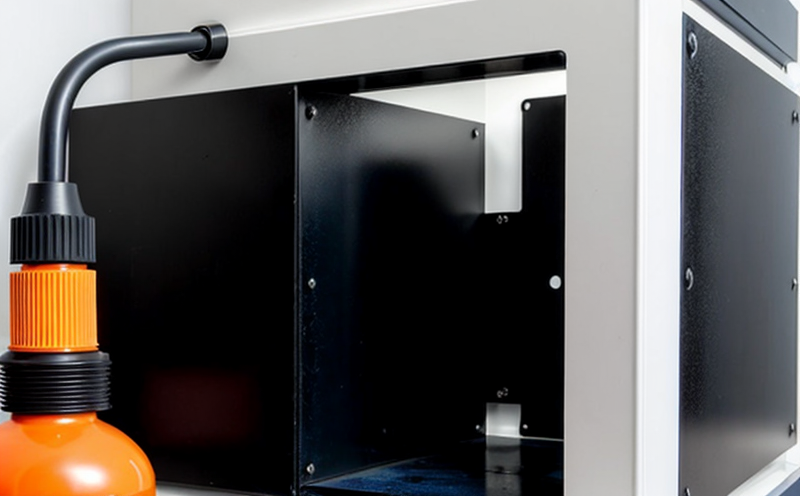ASTM E2834 Nanocoating Thickness Measurement by X Ray Fluorescence
The ASTM E2834 standard provides a method to measure nanocoating thickness using X-ray fluorescence (XRF) spectroscopy. This technique is essential for ensuring that nanocoatings meet specified thickness requirements, which can significantly impact the performance and durability of materials in various sectors.
Typically, nanocoatings are used in industries such as automotive, aerospace, electronics, and construction where precise control over coating thickness is critical. The ASTM E2834 method allows for accurate and repeatable measurements that help ensure compliance with industry standards and customer specifications. This service ensures not only the quality of the coatings but also their performance under real-world conditions.
The XRF technique works by bombarding a specimen with X-rays, which causes atoms in the coating to emit characteristic X-rays. The energy of these emitted X-rays is unique to each element present, allowing for identification and quantification of the elements within the nanocoating. This method provides high sensitivity and precision, making it suitable for measuring very thin layers such as those found in nanocoatings.
Specimen preparation plays a crucial role in obtaining accurate results using ASTM E2834. The coating must be intact and undamaged to ensure that the X-rays interact with only the intended layer. Preparation methods may include cleaning, drying, and ensuring the coating is free from contaminants before measurement.
The instrumentation used for this service includes an XRF spectrometer capable of detecting elements down to trace levels. Calibration standards are essential to ensure accurate measurements across all samples. The spectrometer must be regularly calibrated using known standards to maintain precision over time.
ASTM E2834 specifies the acceptance criteria, which include a range within which the measured thickness must fall to meet specifications. This range is determined based on the desired performance of the coating and any relevant industry standards or customer expectations. Compliance with these criteria ensures that the nanocoating will perform as intended in its application.
The ASTM E2834 method is widely recognized for its reliability and accuracy, making it a preferred choice among quality managers, compliance officers, R&D engineers, and procurement specialists who require precise measurements of nanocoatings. The results obtained from this method can be used to make informed decisions about product development, production processes, and quality control.
In summary, ASTM E2834 provides a robust framework for measuring nanocoating thickness using X-ray fluorescence spectroscopy. This service is vital for maintaining high standards of quality and ensuring that nanocoatings meet the necessary performance requirements in various sectors.
Why It Matters
The accuracy and precision of ASTM E2834 measurements are crucial for industries relying on nanocoatings. These coatings are used to enhance properties such as durability, corrosion resistance, adhesion, and appearance. Inaccurate thicknesses can lead to compromised performance, increased maintenance costs, or even failure in critical applications.
For instance, in the automotive industry, improper coating thickness could result in premature wear and tear of vehicle components, leading to safety issues. In electronics manufacturing, inadequate nanocoating might cause short circuits or other electrical malfunctions. Ensuring compliance with ASTM E2834 standards can prevent these issues by guaranteeing that coatings are applied within specified limits.
The ability to measure nanocoatings accurately also supports continuous improvement efforts in product development and production processes. By regularly monitoring coating thickness, manufacturers can identify trends and make necessary adjustments to improve the quality of their products. This not only enhances customer satisfaction but also contributes to sustainable practices by minimizing waste and resource usage.
Compliance with ASTM E2834 is also important for regulatory purposes. Many industries are subject to strict regulations regarding product safety, environmental impact, and consumer health. Ensuring that nanocoatings meet the required thicknesses helps companies avoid legal issues and maintain a positive reputation in the market.
Competitive Advantage and Market Impact
- Accurate measurement ensures compliance with industry standards and customer specifications, giving competitive edge over non-compliant competitors.
- Precision measurements can lead to improved product performance, which enhances customer satisfaction and loyalty.
- Consistent adherence to ASTM E2834 helps companies maintain a strong reputation in the market, attracting more business opportunities.
The use of ASTM E2834 in nanocoating thickness measurement provides significant competitive advantages. By ensuring that coatings are applied within specified limits, companies can differentiate themselves from competitors who may not adhere to such stringent standards. This precision also leads to improved product performance, which enhances customer satisfaction and loyalty.
Consistent adherence to ASTM E2834 helps companies maintain a strong reputation in the market, attracting more business opportunities. In an increasingly competitive global marketplace, having a proven track record of quality is crucial for securing contracts and expanding into new markets. The precision and reliability provided by this method make it a valuable asset for any company operating within sectors that rely on nanocoatings.
Use Cases and Application Examples
- In the aerospace industry, precise measurement of nanocoating thickness is essential to ensure aircraft components are protected against environmental factors like moisture and corrosion. This helps maintain safety standards and extends the lifespan of critical parts.
- In electronics manufacturing, accurate nanocoating thickness measurements are necessary to prevent shorts and other electrical malfunctions that could disrupt production processes or affect product quality.
The use cases for ASTM E2834 in nanocoating thickness measurement extend across multiple industries. In the automotive sector, manufacturers rely on this method to ensure proper protection of vehicles against wear and tear, thereby enhancing overall vehicle performance.
For construction materials, accurate coating measurements are crucial for achieving the desired aesthetic and functional properties. This ensures that buildings meet both design and practical requirements.
In summary, ASTM E2834 provides a reliable method for measuring nanocoating thickness across various industries where precision is paramount. The applications range from protecting critical components in aerospace to ensuring quality in construction materials.





